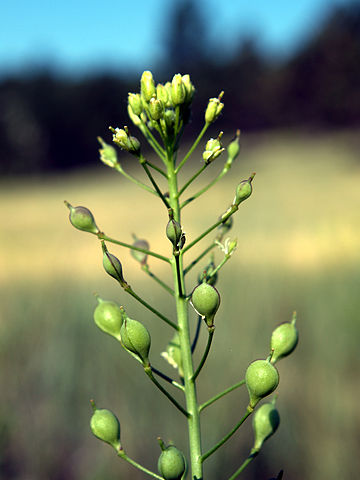
Good News for Kior: EPA Greenlights Camelina and Energy Cane
Apr 2, 2013 - Jim Lane - altenergystocks.com

Camelina microcarpa, aka Littlepod false flax. Photo
by Jim Pisarowicz, National Park Service
New renewable feedstock OKs. Good news, bad, neutral?
In Washington, the US Environmental Protection Agency
issued a final rule qualifying biofuels produced
from camelina oil as biomass-based diesel or advanced
biofuel, as well as biofuels from energy cane which
qualify as cellulosic biofuel.
This final rule also
qualifies renewable gasoline and renewable gasoline
blendstock made from certain qualifying feedstocks
as cellulosic biofuel.
“This decision adds
to the growing list of biodiesel feedstocks that
meet the EPA’s standards for Advanced Biofuel and
gives us yet another option for producing sustainable,
domestic biodiesel that displaces imported oil,”
said Anne Steckel, NBB’s vice president of federal
affairs. “This is important for our energy security,
for our economy and for addressing climate change,
and we thank the EPA for conducting a thorough and
fair review.”
By qualifying these
new fuel pathways, this rule provides opportunities
to increase the volume of advanced, low-GHG renewable
fuels— such as cellulosic biofuels— under the RFS
program. EPA’s comprehensive analyses show significant
lifecycle GHG emission reductions from these fuel
types, as compared to the baseline gasoline or diesel
fuel that they replace.
Lastly, the rule clarifies
the definition of renewable diesel to explicitly
include jet fuel. This clarification offers additional
market certainty and opportunity for renewable diesel
producers.
Rulemaking Process
EPA published a direct
final rule and a parallel proposed rule in January
2012 to amend the RFS regulations, but subsequently
received adverse comment on certain aspects of the
direct final rule and in March 2012, EPA withdrew
the direct final rule.
EPA commented: “The
adverse comments we received centered on a few narrow
aspects of the assumptions underlying the greenhouse
gas (GHG) estimates of producing biofuel feedstocks,
including camelina, energy cane, napier grass, giant
reed and corn stover. These comments were based on
a misinterpretation of our analysis.
“In this final rule,
we provide additional clarification regarding our
assumptions, and the underlying analysis remains
unchanged from the proposed rule.
“Commenters also stated
the direct final rule did not properly address issues
related to control of invasive species. The information
provided did not raise significant concerns about
the threat of invasiveness and related GHG emissions
for camelina and energy cane. Therefore, we are finalizing
the camelina and energy cane pathways in this rule
based on our lifecycle analysis.”
No joy for elephant grass and arundo
EPA commented: “We
are not finalizing at this time determinations on
biofuels produced from giant reed (Arundo donax)
or napier grass (Pennisetum purpureum), or biodiesel
produced from esterification. We continue to consider
the issues concerning these proposals, and will make
a final decision on them at a later time.”
Pathway Determinations
The final rule describes
EPA’s analysis and determinations for the following
new fuel pathways:
Camelina oil
• Biodiesel and renewable
diesel (including jet fuel and heating oil)— qualifying
as biomass-based diesel and advanced biofuel
• Naphtha and liquefied petroleum gas (LPG)— qualifying
as advanced biofuel
Energy cane cellulosic
biomass
• Ethanol, renewable
diesel (including renewable jet fuel and heating
oil), and naphtha— qualifying as cellulosic biofuel
Renewable gasoline
and renewable gasoline blendstock
• Produced from crop
residue, slash, pre-commercial thinnings, tree residue,
annual cover crops, and cellulosic components of
separated yard waste, separated food waste, and separated
municipal solid waste (MSW)
• Using the following
processes— all utilizing natural gas, biogas, and/or
biomass as the only process energy sources— qualifying
as cellulosic biofuel:
o Thermochemical pyrolysis
o Thermochemical gasification
o Biochemical direct fermentation
o Biochemical fermentation with catalytic upgrading
o Any other process that uses biogas and/or biomass
as the only process energy sources
Winners and losers

Well, clearly any
venture woking with camelina or energy cane. But
there’s some love in there for jet fuel, pyrolysis
and a host of other processing technologies that
had aimed at cellulosic biofuels.
It’s good news for
KiOR, Inc. (KIOR) and Dynamic Fuels, too.
Losers? For the time
being, it puts a kibosh on some of the plans at Beta
Renewables to employ arundo donax as a feedstock
for cellulosic biofuels.
The bottom line
It’s an incredible
leap forward in terms of broadening opportunities
to meet RFS targets with a broader range of feedstocks,
conversion technologies and downstream products and
by-products.
There are ever more
way to earn RINs — although, suffice to say, it would
have been more exciting if there had been go-to major
projects that were immediate beneficiaries.

|